Chopping Mall
Chopping Mall was my first blog, which I started way back in 2009. It was dedicated exlcusively to ridiculous and terrible films, which I watched a lot of back then. (So much time, so little work!)
I’ve resuced the posts from oblivion, to be preserved here for …uh… whatever.
It’s a pretty clunky process getting them out of blogspot (XML export, eww) and into here, so there may be a few formatting issues.
More from Bradford
Juan of the Dead, the first film I saw at the Bradford Film Festival this year, was by far and away the most ‘Chopping Mall’ themed film of the bunch. The others were a curious bag of experimental and inventive footage that are certainly worth a mention though. I seriously doubt any of them are in line for a DVD release any time soon, so they might be a little harder to track down, but they’re all worth a watch - and as distribution moves more and more towards digital methods, they may well be available at some point.
First up: Vikingland!

Vikingland’s story is a bizarre one (and possibly even more interesting than the film itself!). The blurb is worth pasting from the official website:
Xurxo Chirro has a passion for record keeping and works in the Archives Department of the local television company. During research, he came upon four video tapes that amounted to 16 hours of rushes and were titled ‘Vikingland’. Luis – an expatriate seaman and a migrant like so many of his fellow Galician countrymen – is the hero of this quite peculiar video saga. This is, indeed, no epic tale but a combination of anecdotes and Luis’ persistence. Between learning how to handle the video camera he has just acquired and the long hours working on the ferry-boat which sails from Denmark to Sylt Island in Germany, where he has been hired as a warehouseman, Luis recorded himself without respite for a whole winter.
So… yes. This is amateur footage shot by a sailor, re-cut by a Galician archive-keeper into something that (supposedly) imitates Moby Dick (Melville is even credited at the end as a writer…). It’s long and it’s slow but also interesting and occasionally amusing. Some of the scenes are almost painfully empty of any action (Luis sets the camera up to watch him moving boxes. We watch him moving boxes. That’s it) but other moments are more compelling.
The extended Galician-sailors’ Christmas dinner is a great scene. The wine-guzzling sailors introduce each dish to the camera and discuss how keen they are to show people what their lives are really like. In this sense it’s a pretty fascinating documentary about the minutae of behind-the-scenes life for the workers in the ship. It is too long, but apart from that it’s got a lot to recommend it. Whether we believe Xurxo Chirro’s story or not, his project is refreshingly real and democratic. There’s no real attempt to make Luis a hero, to explain his history or future, but we’re invited into his little cabin and get to see life as he does.
Next up: Moscow Diary.
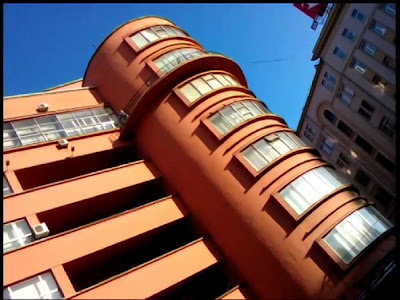
Here, we’re invited to follow Walter Benjamin’s footsteps around Moscow, which he visited for six weeks in the 1920s. It’s shot entirely on a mobile phone and, as we wander the streets, parts of Benjamin’s diary are read out to accompany the film. Although he was partly there to have a look at communism in action, the main purpose for his trip was to pursue actress Asja Lacis with who he was apparently madly in love. Given that I only know Benjamin from his writings on aesthetics and technology and his academic reputation, being shown the fragile and human side to him was quite a surprise. His sad reflections on having waited up all evening in the hope that Asja would swing by are sometimes unsettlingly pathetic: it’s hard to reconcile the philosopher with the lovesick boy.
Visually, the film’s a bit uneven. The mobile-camera works well for the most part - it’s held steady and the image is decent, if not great - but that makes Adam Kossoff’s choice to occasionally use zoomed in shots puzzling because the low-resolution makes it look a right mess. I’m pretty sure by now it’s not a nostalgia-based illusion: low quality digital footage looks a lot worse than low quality film.
Moscow Diary was paired with another mid-length film about Walter Benjamin (you wait ages for a film about Benjamin and then two come along at once…) : Les Anges de Port-Bou (The Angels of Portbou)
In this one, Parisian (?) Benjamin-obsessive Séraphin comes out by train to the border with Spain to recreate Benjamin’s last journey, fleeing France for what he hoped would be safety in Spain, before eventually killing himself in the Spanish town of Portbou.
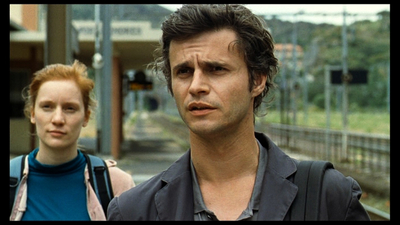
Instead of his friend, who’s supposed to be walking with him, he’s met by his friend’s sister, Gabrielle, who Séraphin reluctantly allows to accompany him across the hills. Their walk ambles between topics, taking in Benjamin’s history, the lives of people in the region and the appeal of mystery amongst other things. It’s a gently told story with plenty left open to interpretation but it’s neatly done, looks beautiful and just flies by. I’d definitely be keen to see more by the director Vladimir Léon.
Juan of the Dead
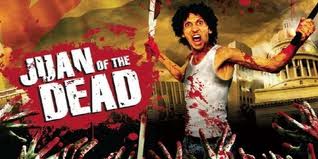
A few months ago, towards the end of last year, the Leeds International Film Festival announced a rather exciting looking UK premiere in the shape of the world’s first Cuban zombie film Juan of the Dead. Sadly, given that I was volunteering at the time (and watching as many films as I could cope with…) I missed it. Given that foreign cult films are sometimes ridiculously slow to appear on DVD here in the UK, I thought I’d missed it altogether. So it was a pretty nice surprise to see the fabulous Bradford Film Festival schedule it as part of their After Dark strand of horror films this year.
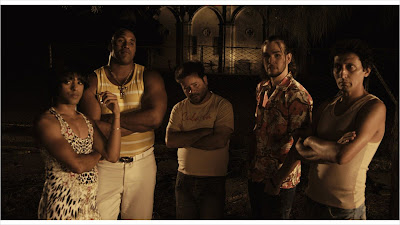
As a lover of many things Spanish/LatinAmerican and all things Zombie, perhaps I was somewhat determined to enjoy this. Even so, sometimes that hyped excitement is the surest way to guarantee disappointment. After all, when you’re looking forward to a film that much it’s going to be hard for it to meet expectations (this is also a worry of mine about Iron Sky, the much-hyped Nazis-on-the-moon adventure…). Thankfully, JotD offered no such disappointment. It was great fun from start to finish.
Juan is a tongue-in-cheek zombie killing rampage with plenty of laughs, some fun gore and not a lot in the way of horror. It’s decidedly more in the Dead Snow and Shaun of the Dead lines than Dawn of the Dead or other more (ahem) ‘serious’ zombie films - this was probably a sensible choice: straight-faced zombie horror can be pretty hard to pull off, especially with a comparatively inexperienced cast (French suburban zombie masterpiece La Horde shows how well it can be done though!). Anyway, Juan sensibly balances laughs and splatter, with the obligatory bit of soul-searching and character improvement.
The basic premise is left beautifully stark. Havana is overrun with zombies. Juan and friends are trying to survive. That’s about all there is to it. Like many of the classics they don’t waste much time on life-before-zombies and they certainly don’t bother explaining where the zombies come from - although the TV reporter blames American imperialists, a neat joke on both Cuban news/propaganda and the (modern) zombie’s links to American consumerism. For the most part it just throws us into the middle of the fray as the Juan, his estranged daughter, his best friend and a couple of others start bashing, slashing, smashing and splattering zombies.
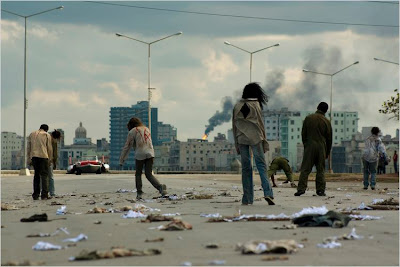
It’s not perfect. But who really expects perfection from a zombie flick? The plot is essentially pretty episodic: Juan and friends go to one place, kill zombies. Another place, kill zombies. Go home. Go out. Kill Zombies. Etc. etc. Luckily it’s all carried out with such obvious enthusiasm that it never really gets boring. It’s slightly spoiled by some astonishingly crappy CGI though. Before computer graphics, designers had to find a convincing way to show something or just not show it. If only this were still true. Shots like a helicopter smashing into Cuban government buildings were obviously prohibitively expensive to shoot properly so would have been better left out entirely. Instead the computer generated helicopter just looks cheap.
The gore’s good though! Some nice splatters, severed limbs and oozing wounds show just what fun you can have with real physical special effects. And, even if it is episodic, some of the episodes are so damn good that you can forgive them entirely: one scene sees the heroes naked, unarmed and handcuffed to a zombie in the back of a van… There are lots of wry jokes at the Cuban regime and it’s claims - the zombies are referred to as dissidents throughout - and one of the characters carries both a Cuban and a US flag to wave depending on who wins. It’s also suitably cavalier with its characters: several central characters meet gruesome ends and, at the beginning at least, the gang seem to accidentally kill as many humans as they do zombies (accidentally shooting an old lady with a harpoon…).
Overall, it’s the enthusiasm that holds this film together. It’s made by people clearly enjoying the chance to make the first Cuban zombie film and their enthusiasm is infectious. Juan is somewhat uneven but so are most zombie films. It’s generally a lot of fun.
(The Bradford Film Festival is screening it again on Sunday 22nd and the film will get a DVD release on 4th June. Hurrah!)
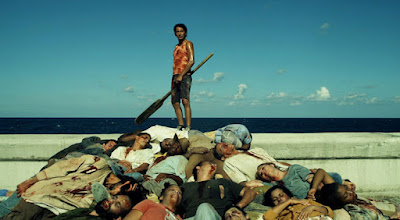
Oscar nominated films? Wuh?
Not a lot of posts since the film festival, huh? December and January were pretty busy months and the blog got somewhat left behind. It’s not like I haven’t seen many films recently but… truth be told, they’ve mostly been pretty good films. Which is unusual.
Chopping Mall was never meant to be exclusively about bad films, b-movies and grindhouse classics but it certainly wasn’t meant to be focused on all the Oscar hopefuls either. As it is, I’ve seen several of the nominees over the last few months, as well as a handful of other classy films that hardly belong here. I’ll gloss over them quickly and then it’ll be time to resume normal service.
Scorsese’s Hugo was a treat. There wasn’t a huge lot of depth to it really - it’s basically just a sweet story about acceptance and family that draws on cinema history - but it did everything it set out to do with style. An absolutely stellar cast meant that this was about revisiting cinema history in more ways than one - Christopher Lee as a librarian was a welcome figure - and, as you’d expect, it looked beautiful.
My Week With Marilyn had an equally stellar cast, was equally obsessed with cinema history and was even more slight. There was nothing wrong with it, exactly, but it wasn’t exactly a memorable experience. The film is little more than what the title describes - a fairly pleasant rich guy spends a fairly pleasant week with Marilyn Monroe who, it turns out, is fairly pleasant. The best thing I can really say for it was that it prompted a watch of Some Like It Hot, with the real Marilyn Monroe boozing her way through prohibition era comedy.
The Artist continued the journey through the current trend of cinema about cinema. Why the current vogue for films about film history? It’s a neatly self-contained self-obsession and there’s plenty of stories to be (re)told but… how much is too much? I hardly need to say anything about The Artist - it’s already had more than enough written about it - but I may as well briefly add my voice to all the others. It’s charming. It’s fun. It’s heart-warming. And pleasant. And nice. And lovely. Oh, it doesn’t put a foot wrong and there’s not a word you can say against it but… some of the praise has probably been overstated.
My final big Oscar film was A Separation, which is a beautifully told but fairly slow tale of divorce, family-ties, pride and lies from Iran. It’s not cheerful stuff but as both a view of Iranian life and a sensitively told story of very human sadness it’s certainly worth a watch.
I think that’s about the lot. Phew. Done with all these classy new films. Back to the cult trash, James Bond and vampire flick. Those were separate, of course. As far as I’m aware no-one has yet made a cult trash James Bond and vampire flick. I’ll be first in line when they do…
James Bond triple bill
So, from the exciting introduction to the Bond universe that Dr No provided, I moved along (chronologically, of course) to a trio of films that pretty much embody what James Bond is. These films are the very peak of ‘Bond-ness’, they’re so jam packed with all the exciting (and ridiculous) tropes that came to define the the Bond film as a series that it’s no surprise that Austin Powers found the vast majority of its material here - some of the scenes are almost shot-for-shot identical!

From Russia With Love (1963 / Terrence Young / Sean Connery)
Goldfinger (1964 / Guy Hamilton / Sean Connery)
Thunderball (1965 / Terrence Young / Sean Connery)
Both From Russia With Love and Thunderball feature Spectre plots for our heroic agent to battle, whilst Goldfinger is much more of a one-man villain. From Russia takes us from the early form of Dr No and ramps it up by throwing a whole lot more excitement at it. Bond now has some serious gadgetry (albeit relatively basic) and his quick-assembly sniper rifle is particularly useful. We also meet some of the most fabulously English of scenes - the foreign spy on the train who gives himself away by drinking red wine with fish! What a mistake! Sean Connery, as ever, is fabulous throughout but I couldn’t help feeling that, whilst From Russia threw an awful lot of exciting elements at the plot, the structure of the story itself was slightly lacklustre. Like Dr No, it had it’s peaks and a few very memorable moments but as a film it was certainly lacking something.
Goldfinger, easily one of the very best of Bond, takes all the elements that From Russia contained and turned them up a bit. Rosa Klebb’s killer shoe becomes Oddjob’s killer hat, a comparatively timid attempt to steal a code-machine becomes an audacious plot to irradiate all of America’s gold, etc. etc. Goldfinger turns the heat up - and possibly overdoes it. Here then, we find lasers! gadget cars! sprayed gas! an implausibly strong Korean! and all sorts of other madness.
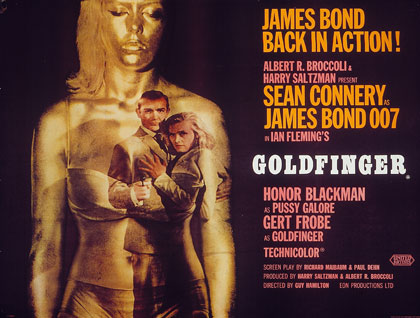
I’d call it a film of hits and misses: when it gets it right, it gets it very right indeed… but occasionally it’s not quite so strong. A prefect example of the latter would be the extended Bond vs. Goldfinger golf showdown. I’ll repeat that: golf. I mean, whoever thought to set a dramatic encounter over a (long) game of golf? When we’ve been teased with bullet-proof cars and tear-gas briefcases, an elaborate ball-swapping plot that centres on Bond’s recognition of the Slazenger 5 golf ball is… boring.
That said, some of the scenes are undeniable classics. The sight of Bond, strapped to a chunk of metal with a high-power metal-cutting laser edging ever closer towards painful emasculation is as unforgettable as James Bond films get. It would be sublime even without dialogue but the now classic exchange “Do you expect me to talk / No Mr Bond, I expect you to die” is so wonderfully blunt that it just makes the scene perfect.
The only thing, to my mind, that really stands in the way of Goldfinger being the absolutely perfect Bond film is the utterly ridiculous names used throughout. So Goldfinger likes gold? And his first name is Auric? Like the element? And his odd job man is er… called OddJob? And the major plan to contaminate Fort Knox is called Operation GrandSlam? And the sex-interest woman is called Pussy Galore? All this and more: Goldfinger is about as subtle as a sledgehammer. Whilst I’d never demand a thoughtful or challenging Bond film, Goldfinger does occasionally feel like it’s treating us like idiots. I had absolutely understood that the sexy woman would have sex with Bond without her being named Pussy Galore (suitably mocked by Austin Powers’ Alotta Fagina). It’s, sadly, the kind of choice that makes this film feel so dated - even more than its two predecessors.

The last time I saw Thunderball - where we’re back with Spectre and have a plot of nuclear-ransom - was before the Austin Powers films; it’s hard to watch it in the same way now. We get scenes in the Spectre lair with ’number one’ frying his cheating agents (whose steaming, but now empty, chairs return to the table), an eye-patched villain and a fantastic opening scene with a Spectre agent dressed as a grieving widow. Bond doesn’t actually shout “That’s a man, maaaaan!” but I could here it in my head…
As a film Thunderball is the most coherent and elaborately plotted yet but (for all that I teased Goldfinger) it lacks some of the more outrageous fun. There’s no decent villain - eyepatch man does little besides giving grumpy orders - but there are some decent scenes (chase scene through the carnival!) and it does hang together as a pretty decent film. Sadly, there are far too many dull action sequences for it to be a true classic… Underwater scenes galore here and none of them are much fun. Some stirring music isn’t enough to save a long, slow, flippers-and-wetsuits harpoon-battle snooze of a scene in what ought to be the most exciting part of the film.
Despite some flaws in each, these three Bond films are a pretty exciting triple-bill of action fun and, taking over where Dr No left off, make a convincing case for crowning Sean Connery as best Bond ever. From here, there’s only one more Connery-Bond left before we come to George Lazenby’s disasterous effort…
Repulsion and Happy People
Three Two more from the Film Festival! Something old, something new, and something informative…
[Bellflower was going to be included in this group… It’ll be coming soon instead…]
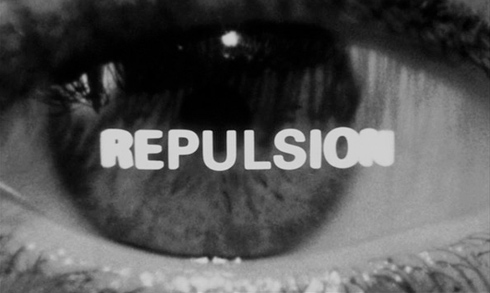
Repulsion
Repulsion is early Polanski and definitely ‘classic’ enough that it’d usually fall way outside the focus of this blog: I tend to lean away from writing about the classics, if only because plenty of people have already written plenty of words about these films - what’s left for me to add? So I’ll be brief…
[There are a couple of nice reviews to be found at Korova Theatre and Radiator Heaven]
Repulsion is a thriller in the old, almost forgotten sense of the world. It thrills. Every single person watching jumped at least once in the film, as poor Carol’s hallucinatory nightmare threw shocks and scares at her in fits and starts. Polanski throws in a wonderful mix of the increasingly repulsive - an uncooked rabbit left out to gather flies and rot - the imaginatively uneasy - a crack in the wall that threatens repeatedly to burst apart - and the threat of real violence - sexually aggressive men pounce at Carol from every corner, some real, some imaginary. It’s edge of the seat stuff that is propelled by a pulsing score and a camera that hovers voyeuristically around doorways and windowframes, beckoning the viewer into Carol’s paranoid fears.
So little of her condition or the realities or origins of her fears is explained that you leave the cinema desperately untangling plot elements in your head, guessing and re-guessing which of the more plausible elements were imagined and which of the more outlandish were real. Great stuff.
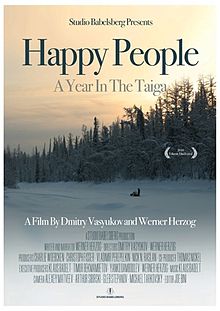
Happy People - A Year in the Taiga
This documentary of Siberian life came with a “Narrated by Werner Herzog” tagline - surely as good a guarantee of an interesting film as there can be. Thankfully, it doesn’t disappoint. We are taken, in a fairly straight-forward manner, through a calendar year in the lives of the trappers/hunters of a a Siberian village in the Taiga. Herzog contributes, as you might imagine if you’ve seen his (fabulous) Encounters at the End of the World, some perfectly dead-pan humour and a fair bit of admiration for the trappers. Occasionally, his wistful reminders that, out in the wilderness, they are free of government, free of taxes, free of bureaucracy, etc. etc. is a little too heavy-handed, but for the most part, his narration fits the documentary well.
Far more impressive than anything Herzog can provide are the demonstrations of traditional skills (especially the making of skis and the hollowing of a dug-out canoe), the rugged philosophy of the trappers and, above all, the sheer beauty of the landscape. The rive they live by and hunt around is an enormous sheet of ice for most of the year and comes slowly to life around May, looking something like a glacier rolling down a valley but much, much faster, carrying enormous chunks of ice as it flows. For the next couple of months it’s navigable by boat, but after that it turns back to ice and becomes the domain of the snow-mobile. Happy People is a fabulous watch and, although occasionally too sentimental, it’s a fascinating window into lifestyles we rarely see.